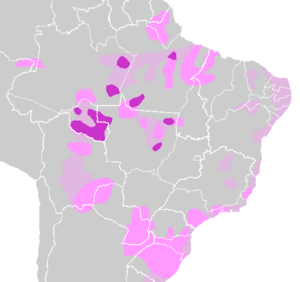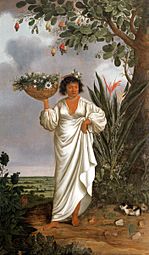Tupi people facts for kids
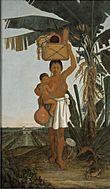 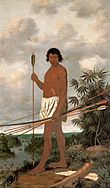
Albert Eckhout's painting of the Tupi
|
|
| Total population | |
|---|---|
| 1,000,000 (historically), Potiguara 10,837, Tupinambá de Olivença 3,000, Tupiniquim 2,630, others extinct as tribes but blood ancestors to Pardo Brazilian population | |
| Regions with significant populations | |
| Central and Coastal Brazil | |
| Languages | |
| Tupi languages, later língua geral, much later Portuguese | |
| Religion | |
| Indigenous, later Christianity | |
| Related ethnic groups | |
| Guaraní tribes |
The Tupi people, a subdivision of the Tupi-Guarani linguistic families, were one of the largest groups of indigenous peoples in Brazil before its colonization. Scholars believe that while they first settled in the Amazon rainforest, from about 2,900 years ago the Tupi started to migrate southward and gradually occupied the Atlantic coast of Southeast Brazil.
Many Tupi people today are merged with the Guaraní people, forming the Tupi–Guarani languages. Guarani languages are linguistically different from the Tupian languages.
Contents
History
The Tupi people inhabited 3/4 of all of Brazil's coast when the Portuguese first arrived there. In 1500, their population was estimated at 1 million people, nearly equal to the population of Portugal at the time. They were divided into tribes, each tribe numbering from 300 to 2,000 people. Some examples of these tribes are: Tupiniquim, Tupinambá, Potiguara, Tabajara, Caetés, Temiminó, Tamoios. The Tupi were adept agriculturalists; they grew cassava, corn, sweet potatoes, beans, peanuts, tobacco, squash, cotton and many others. There was not a unified Tupi identity despite the fact that they spoke a common language.
European colonization
Upon discovering the existence of the Tupi people, it was assumed by Portuguese settlers that they lacked any sort of religion, a belief that began the process of assimilating the Tupi to Christianity. The settlers began erecting villages for the Tupi, known as aldeias, with the intention of more disciplined religious conversion and institutionalization of European customs. Aside from being assimilated, the Tupi were found to be of use to the Portuguese, who required laborers for cultivating and shipping their exports. This use in harvesting resources led to their eventual enslavement and in turn, the spread of fatal European diseases on the plantations they worked at. This combination of factors nearly led to their complete annihilation, with the exception of a few isolated communities. The remnants of these tribes are today confined to indigenous territories or acculturated to some degree into the dominant society.
Race-mixing and Cunhadismo=
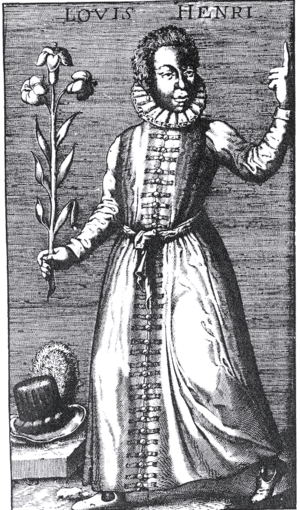
Many indigenous peoples were important for the formation of the Brazilian people, but the main group was the Tupi. When the Portuguese explorers arrived in Brazil in the 16th century, the Tupi were the first indigenous group to have contact with them. Soon, a process of mixing between Portuguese settlers and indigenous women started. The Portuguese colonists rarely brought women, making the native women the "breeding matrix of the Brazilian people". When the first Europeans arrived, the phenomenon of "cunhadismo" (from Portuguese cunhado, "brother in law") began to spread by the colony. Cunhadismo was an old native tradition of incorporating strangers to their community. The Natives offered the Portuguese an Indigenous girl as wife. Once he agreed, he formed a bond of kinship with all the Natives of the tribe. Polygyny, a common practice among South American Indigenous people, was quickly adopted by European settlers. This way, a single European man could have dozens of indigenous wives (temericós).
Cunhadismo was used as recruitment of labour. The Portuguese could have many temericós and thus a huge number of Indigenous relatives who were induced to work for him, especially to cut pau-brasil and take it to the ships on the coast. In the process, a large mixed-race (mameluco) population was formed, which in fact occupied Brazil. Without the practice of cunhadismo, the Portuguese colonization was impractical. The number of Portuguese men in Brazil was very small and Portuguese women were even fewer in number. The proliferation of mixed-race people in the wombs of indigenous women provided for the occupation of the territory and the consolidation of the Portuguese presence in the region.
Influence in Brazil
Although the Tupi population largely disappeared because of European diseases to which they had no resistance or because of slavery, a large population of maternal Tupi ancestry occupied much of Brazilian territory, taking the ancient traditions to several points of the country. Darcy Ribeiro wrote that the features of the first Brazilians were much more Tupi than Portuguese, and even the language that they spoke was a Tupi-based language, named Nheengatu or Língua Geral, a lingua franca in Brazil until the 18th century. The region of São Paulo was the biggest in the proliferation of Mamelucos, who in the 17th century under the name of Bandeirantes, spread throughout the Brazilian territory, from the Amazon rainforest to the extreme South. They were responsible for the major expansion of the Iberian culture in the interior of Brazil. They acculturated the indigenous tribes who lived in isolation, and took the language of the colonizer, which was not Portuguese yet, but Nheengatu itself, to the most inhospitable corners of the colony. Nheengatu is still spoken in certain regions of the Amazon, although the Tupi-speaking Natives did not live there. The Nheengatu language, as in other regions of the country, was introduced there by Bandeirantes from São Paulo in the 17th century. The way of life of the Old Paulistas could almost be confused with the Natives. Within the family, only Nheengatu was spoken. Agriculture, hunting, fishing and gathering of fruits were also based on indigenous traditions. What differentiated the Old Paulistas from the Tupi was the use of clothes, salt, metal tools, weapons and other European items.
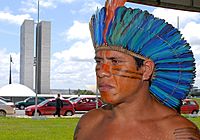
When these areas of large Tupi influence started to be integrated into the market economy, Brazilian society gradually started to lose its Tupi characteristics. The Portuguese language became dominant and Língua Geral virtually disappeared. The rustic indigenous techniques of production were replaced by European ones, in order to elevate the capacity of exportation. Brazilian Portuguese absorbed many words from Tupi. Some examples of Portuguese words that came from Tupi are: mingau, mirim, soco, cutucar, tiquinho, perereca, tatu. The names of several local fauna – such as arara ("macaw"), jacaré ("South American alligator"), tucano ("toucan") – and flora – e.g. mandioca ("manioc") and abacaxi ("pineapple") – are also derived from the Tupi language. A number of places and cities in modern Brazil are named in Tupi (Itaquaquecetuba, Pindamonhangaba, Caruaru, Ipanema). Anthroponyms include Ubirajara, Ubiratã, Moema, Jussara, Jurema, Janaína. Tupi surnames do exist, but they do not imply any real Tupi ancestry; rather they were adopted as a manner to display Brazilian nationalism.
The Tupinambá tribe is fictitiously portrayed in Nelson Pereira dos Santos' satirical 1971 film How Tasty Was My Little Frenchman (Como Era Gostoso o Meu Francês). Its name is also adapted by science: Tupinambis is a genus of tegus, arguably the best-known lizards of Brazil.
The large offshore Tupi oil field discovered off the coast of Brazil in 2006 was named in honor of the Tupi people.
The Guaraní are a different native group that inhabits southern Brazil, Uruguay, Paraguay, and northern Argentina and speaks the distinct Guaraní languages, but these are in the same language family as Tupi.
Notable Tupi people
- Catarina Paraguaçu, 1528—1586
- Araribóia, founder of Niterói, Brazil
- Cunhambebe
See also
 In Spanish: Pueblos tupíes para niños
In Spanish: Pueblos tupíes para niños
- De Gestis Meni de Saa
- Guaraní War
- José de Anchieta
- Língua Geral
- Manuel da Nóbrega
- Tupian languages


